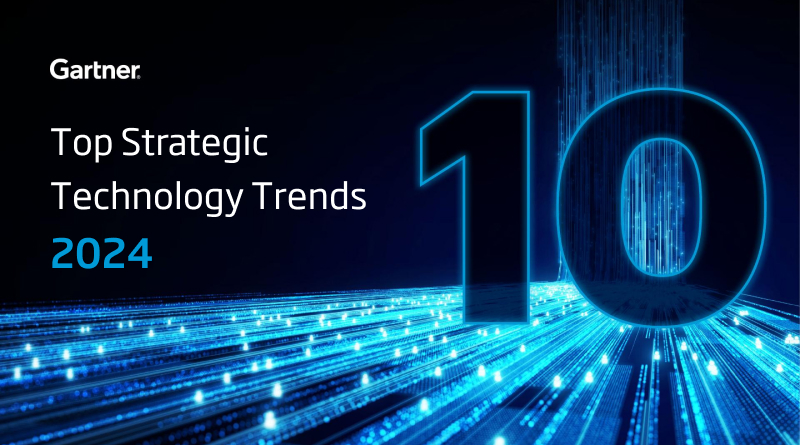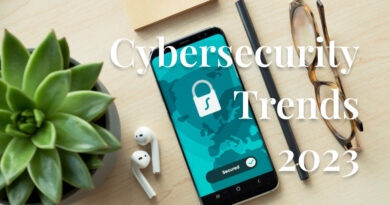Analyzing Gartner’s technology trends for this 2024
Once again this year, the Gartner Group has published its list of the top ten technology trends for 2024, so let’s see which technologies are considered to be breakthroughs for this year.
As always, after registering you can download the official Gartner document on technology trends at this link.
Having said that, let’s analyze what they say.
Big Picture
Each of the defined trends is related to one or more key issues for companies:
- Protecting and preserving past and future investments.
- Creating the right solutions for stakeholders at the right time.
- Delivering value to the changing environment of internal and external customers.

Themes
We will now analyze each of these topics and their technological trends.

Theme 1: Protect your investment
To ensure a sustained impact of technology investments, it will be necessary to:
- Deliberate: uncontrolled experimentation with insufficient direction will have to stop. Efforts must be intentional and produce solid results for daily use.
- Be realistic: the ROI of projects must be calculated, taking into account the necessary protective measures from the outset.
- Be proactive. innovations will need to be adapted with future reuse in mind, while rights (i.e. intellectual property and ownership of creations) and a lasting position in the future will need to be secured.
IT trends that fall into this category are:
- AI Trust, Risk and Security Management (AI TRiSM).
- Continuous Threat Exposure Management (CTEM).
- Industry Cloud Platforms.
- Sustainable Technology.
- Democratized Generative AI.
Theme 2.- The rise of builders
The creative powers of communities dedicated to the creation of applications and solutions must be unleashed. To this end:
- Technologies that are adapted to our industry, specific organizational needs and specialized workers will be used.
- A roadmap will need to be developed to enable non-specialists to create content.
- Work closely with business stakeholders to determine software delivery and portfolio lifecycle management.
The IT trends that fall under this theme are:
- Platform Engineering.
- AI-Augmented Development.
- Industry Cloud Platforms.
- Intelligent Applications.
- Sustainable Technology.
- Democratized Generative AI.
Theme 3: Deliver the value
It is vital to refine and accelerate how to improve stakeholder experience, as well as expand options for generating revenue. To this end:
- It will be necessary to continually adjust to changing customer demands, both internal and external, to create a virtuous circle of value determination and delivery.
- Algorithm-based customer approaches, whose influence is growing rapidly, will have to be included.
- Controlled access to rapidly evolving digital tools, whether related to generative artificial intelligence, workforce training and migration, or other augmentation and automation opportunities, will need to be facilitated.
The IT trends that fall under this theme are:
- Machine Customers.
- Augmented Connected Workforce.
- Intelligent Applications.
- Sustainable Technology.
- Democratized Generative AI.
Technology Trends
We will now take a brief look at what each of these trends consists of.
1.- AI Trust, Risk and Security Management
The popularization of access to artificial intelligence has underscored the urgency and clarity in the need for Trust, Risk, and Security Management (TRiSM) in artificial intelligence (AI). Without protective measures, AI models can quickly generate negative effects that accumulate and spiral out of control, overshadowing any positive benefits that AI may offer in terms of performance and societal gains. TRiSM in AI provides tools for ModelOps, active data protection, AI-specific security, model monitoring (including detecting changes in data, models, and/or unintended outcomes), and risk controls for inputs and outputs to third-party models and applications.
According to Gartner, it is projected that by 2026, companies implementing TRiSM controls in AI will improve the accuracy of their decisions by eliminating up to 80% of faulty and invalid information.
2.- Continuous Threat Exposure Management
Continuous Threat Exposure Management (CTEM) is a pragmatic and systematic approach that allows companies to continuously and consistently assess the accessibility, exposure, and exploitability of their digital and physical assets. Aligning the assessment and remediation scopes of CTEM with threat vectors or business projects, rather than focusing on infrastructure components, reveals not only vulnerabilities but also threats that cannot be corrected.
According to Gartner, by 2026, organizations prioritizing their security investments based on a CTEM program are expected to experience a 66% reduction in security breaches.
3.- Sustainable Technology
Sustainable technology refers to a set of digital solutions designed to promote environmental, social, and corporate governance (ESG) outcomes that support long-term ecological balance and human rights. The use of technologies such as artificial intelligence, cryptocurrencies, the Internet of Things, and cloud computing is raising concerns about energy consumption and associated environmental impacts. This highlights the importance of ensuring that the use of information technologies is more efficient, circular, and sustainable. According to Gartner, by 2027, it is estimated that 25% of Chief Information Officers (CIOs) will see their personal compensation linked to the impact of sustainable technology.
4.- Platform Engineering
Platform engineering involves creating and maintaining internal development systems that can be used autonomously. Each platform, managed by a specialized team, is designed to meet the needs of its users by connecting with various tools and processes. The purpose of this discipline is to enhance productivity, user experience, and accelerate the delivery of business value.
5.- AI-Augmented Development
Enhanced by artificial intelligence, development involves the use of technologies like GenAI and machine learning to aid software engineers in the creation, programming, and testing of applications. AI-assisted software engineering enhances developers’ efficiency and empowers development teams to address the increasing demand for software required for business operations. These AI-enriched development tools allow software engineers to reduce the time spent writing code, enabling them to focus more on strategic activities such as designing and creating compelling business applications.
6.- Industry Cloud Platforms
By the year 2027, Gartner predicts that over 70% of companies will utilize industry-specific cloud platforms (ICPs) to drive their business initiatives, a significant increase from less than 15% in 2023. ICPs focus on achieving industry-relevant business outcomes by combining various software-as-a-service (SaaS), platform-as-a-service (PaaS), and infrastructure-as-a-service (IaaS) services into a comprehensive offering with adaptable capabilities. These platforms typically include specialized industry data structures, a range of packaged business capabilities, composition tools, and other innovations. Moreover, ICPs are cloud proposals specifically tailored for a particular industry and can be further customized to meet the specific needs of an organization.
7.- Intelligent Applications
Smart applications incorporate intelligence, which Gartner defines as the learned adaptation capability to respond appropriately and autonomously. This intelligence can be utilized in various use cases to enhance or automate work. As a core capability, intelligence in applications encompasses various artificial intelligence-based services, such as machine learning, vector stores, and connected data. Consequently, smart applications offer experiences that dynamically adapt to the user.
There is a clear need and demand for smart applications. Twenty-six percent of CEOs in the 2023 Gartner CEO and Senior Business Executive Survey cited talent shortage as the most detrimental risk to their organization. Attracting and retaining talent is the top workforce priority for CEOs, while artificial intelligence was named the technology that will have the most significant impact on their industries in the next three years.
8.- Democratized Generative AI
Generative Artificial Intelligence (GenAI) is becoming more accessible thanks to pre-trained models, cloud computing, and open source. According to Gartner, by 2026, over 80% of companies will have used GenAI in their applications, compared to less than 5% in 2023.
GenAI enables access to vast amounts of information for business users, democratizing knowledge within companies. These models allow workers to access knowledge in an easier and more conversational manner.
9.- Augmented-Connected Workforce (ACWF)
The Augmented and Connected Workforce (ACWF) is a strategy to optimize the value derived from human workers. The need to accelerate and scale talent is driving the ACWF trend. ACWF utilizes intelligent applications and workforce analytics to provide daily context and guidance that support workforce experience, well-being, and skill development. At the same time, ACWF drives business results and positive impact for key stakeholders.
By 2027, 25% of CIOs will use augmented and connected workforce initiatives to reduce the time required to achieve competency by 50% for key roles.
10.- Machine Customers
Machine customers (also known as “custobots”) are non-human economic actors that can autonomously negotiate and purchase goods and services in exchange for payment. By 2028, there will be 15 billion connected products with the potential to behave as customers, with billions more to follow in the coming years. This growth trend will be the source of trillions of dollars in revenue by 2030 and will eventually become more significant than the advent of digital commerce. Strategic considerations should include opportunities to facilitate these algorithms and devices, or even create new custobots.
More information: Gartner Press Release
Header Image: Gartner





